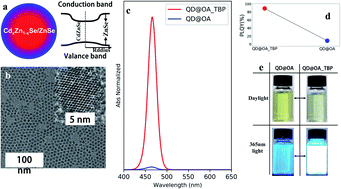High efficiency blue light-emitting devices based on quantum dots with core-shell structure design and surface modification
Abstract
Blue quantum dot (QD) light emitting diode (QLED) developments are far lagging behind the red and green ones as it becomes difficult to balance charge injection and photo stability than the latter. Here, we introduced a combination of a low band energy shell with better surfactants, which largely meet both abovementioned requirements. Our simulation pinpoints that it is the exposed Se on the QD surface, which causes non-radiative relaxations. By adding tributyl phosphine (TBP), which is a good ligand to Se, we recover photoluminescence quantum yield (PLQY) from less than 8.0% up to above 85.0%. The corresponding external quantum efficiency (EQE) of QLEDs increases from 3.1% to 10.1%. This demonstrates that the low bandgap shell with effective surfactant passivation is a promising strategy to enhance QLED performance.



 Please wait while we load your content...
Please wait while we load your content...